Historical Phosphorus Kinetics and Ambient Orthophosphate Concentrations in the St. Lawrence Great Lakes Erie, Huron, Michigan, St. Clair, and Superior by a Modified Inverse Isotope Dilution Method
Abstract
1. Introduction
2. Materials and Methods
3. Results
3.1. P-33 Turnover Rates Under Ambient (No Add) Conditions in 1993
3.2. P-33 Turnover Rates Under Ambient (No Add) Conditions in 1997
3.3. Kill Experiments
3.4. Cold Chase Experiments
3.5. Estimation of Ambient P0 Concentrations
4. Discussion
5. Conclusions
Funding
Institutional Review Board Statement
Informed Consent Statement
Data Availability Statement
Acknowledgments
Conflicts of Interest
References
- Singh, N.K.; Van Meter, K.J.; Basu, N.B. Widespread increases in soluble phosphorus concentrations in streams across the transboundary Great Lakes Basin. Nat. Geosci. 2023, 16, 893–900. [Google Scholar] [CrossRef]
- Barbiero, R.P.; Lesht, B.M.; Warren, G.J. Convergence of trophic state and the lower food web in Lakes Huron, Michigan, and Superior. 2012. J. Great Lakes Res. 2012, 38, 368–380. [Google Scholar] [CrossRef]
- Barbiero, R.P.; Rudstam, L.G.; Watkins, J.M.; Lesht, B.M. A cross-lake comparison of crustacean zooplankton communities in the Laurentian Great Lakes, 1997–2016. J. Great Lakes Res. 2019, 45, 672–690. [Google Scholar] [CrossRef]
- Bunnell, D.B.; Barbiero, R.P.; Ludsin, S.A.; Madenjian, C.P.; Warren, G.J.; Dolan, D.M.; Brenden, T.O.; Briland, R.; Gorman, O.T.; He, J.X.; et al. Changing ecosystem dynamics in the Laurentian Great Lakes: Bottom-Up and Top-Down regulation. Bioscience 2014, 64, 26–39. [Google Scholar] [CrossRef]
- Pothoven, S.A.; Vanderploeg, H.A. Variable changes in zooplankton phenology associated with the disappearance of the spring phytoplankton bloom in Lake Michigan. Freshw. Biol. 2021, 67, 365–377. [Google Scholar] [CrossRef]
- Pothoven, S.A.; Fahnenstiel, G.L. Spatial and temporal trends in zooplankton assemblages along a nearshore to offshore transect in southeastern Lake Michigan from 2007 to 2012. J. Great Lakes Res. 2014, 41, 95–103. [Google Scholar] [CrossRef]
- Bunnell, D.B.; Keeler, K.M.; Puchala, E.A.; Davis, B.M.; Pothoven, S.A. Comparing seasonal dynamics of the Lake Huron zooplankton community between 1983–1984 and 2007 and revisiting the impact of Bythotrephes planktivory. J. Great Lakes Res. 2012, 38, 451–462. [Google Scholar] [CrossRef]
- Barbiero, R.P.; Bunnell, D.B.; Rockwell, D.C.; Tuchman, M.L. Recent increases in the large glacial-relict calanoid Limnocalanus macrurus in Lake Michigan. J. Great Lakes Res. 2009, 35, 285–292. [Google Scholar] [CrossRef]
- Barbiero, R.P.; Balcer, M.; Rockwell, D.C.; Tuchman, M.L. Recent shifts in the crustacean zooplankton community of Lake Huron. Can. J. Fish. Aquat. Sci. 2009, 66, 816–828. [Google Scholar] [CrossRef]
- Bunnell, D.B.; Davis, B.M.; Warner, D.M.; Chriscinske, M.A.; Roseman, E.F. Planktivory in the changing Lake Huron zooplankton community: Bythotrephes consumption exceeds that of Mysis and fish. Freshw. Biol. 2011, 56, 1281–1296. [Google Scholar] [CrossRef]
- Lehman, J.T. St. Lawrence Great Lakes Dataset [Data set], University of Michigan—Deep Blue Data 2024. Available online: https://deepblue.lib.umich.edu/data/concern/data_sets/fx719n39v (accessed on 26 February 2025).
- Lehman, J.T. Historical Upper Great Lakes dataset: Introduction and analyses. J. Great Lakes Res. 2025, 51, 102464. [Google Scholar] [CrossRef]
- Lehman, J.T.; Burgess, S. Stable isotope analysis of planktonic lower food webs of Lakes Erie, Huron, Michigan and Superior. Limnol. Rev. 2024, 24, 506–519. [Google Scholar] [CrossRef]
- Rigler, F.H. Further observations inconsistent with the hypothesis that the molybdenum blue method measures orthophosphate in lakewater. Limnol. Oceanogr. 1968, 13, 7–13. [Google Scholar] [CrossRef]
- Tarapchak, S.J.; Herche, L.R. Phosphate uptake by microorganisms in lake water: Deviations from simple Michaelis-Menten kinetics. Can. J. Fish. Aquat. Sci. 1986, 43, 319–328. [Google Scholar]
- Tarapchak, S.J.; Herche, L.R. Orthophosphate concentrations in lake water; Analysis of Rigler’s radiobioassay method. Can. J. Fish. Aquat. Sci. 1988, 45, 2230–2237. [Google Scholar] [CrossRef]
- Effler, S.W.; Prestigiacomo, A.R.; Hairston, N.G.; Auer, M.T.; Kuczynski, A.; Chapra, S.C. Dissolved phosphorus concentrations in Cayuga Lake system and differences from two analytical protocols. Lake Res. Manag. 2016, 32, 392–401. [Google Scholar] [CrossRef]
- Rigler, F.H. Radiobiological analysis of inorganic phosphorus in lakewater. Verh. Int. Ver. Limnol. 1966, 16, 486–489. [Google Scholar]
- Wen, Y.H.; Vezina, A.; Peters, R.H. Allometric scaling of compartmental fluxes of phosphorus in freshwater algae. Limnol. Oceanogr. 1997, 42, 45–56. [Google Scholar] [CrossRef]
- Karl, D.M.; Tien, G. MAGIC: A sensitive and precise method for measuring dissolved phosphorus in aquatic environments. Limnol. Oceanogr. 1992, 37, 105–116. [Google Scholar]
- Anagnostou, E.; Sherrell, R.M. MAGIC method for subnanomolar orthophosphate determination in freshwater. Limnol. Oceanogr. Methods 2008, 6, 64–74. [Google Scholar] [CrossRef]
- Lin, P.; Klump, J.V.; Guo, L. Dynamics of dissolved and particulate phosphorus influenced by seasonal hypoxia in Green Bay, Lake Michigan. Sci. Total Environ. 2016, 541, 1070–1082. [Google Scholar] [CrossRef]
- Baehr, M.M.; McManus, J. The measurement of phosphorus and its spatial and temporal variability in the western arm of Lake Superior. J. Great Lakes Res. 2003, 29, 479–487. [Google Scholar]
- Sterner, R.W. The Laurentian Great Lakes: A biochemical test bed. Annu. Rev. Earth Planet. Sci. 2021, 49, 201–229. [Google Scholar] [CrossRef]
- Lin, P.; Guo, L. Dynamic changes in the abundance and chemical speciation of dissolved and particulate phosphorus across the river-lake interface in southwest Lake Michigan. Limnol. Oceanogr. 2016, 61, 771–789. [Google Scholar] [CrossRef]
- Paerl, H.W.; Lean, D.R.S. Visual observations of phosphorus movement between algae, bacteria, and abiotic particles in lake water. J. Fish. Res. Board Can. 1976, 33, 2805–2813. [Google Scholar]
- Currie, D.J.; Kalff, J. The relative importance of bacterioplankton and phytoplankton in phosphorus uptake in freshwater. Limnol. Oceanogr. 1984, 29, 311–321. [Google Scholar] [CrossRef]
- Cotner, J.B.; Wetzel, R.G. Uptake of dissolved inorganic and organic phosphorus compounds by phytoplankton and bacterioplankton. Limnol. Oceanogr. 1992, 37, 232–243. [Google Scholar]
- Heath, R.T.; Munawar, M. Significance of the microbial food web to carbon and phosphorus dynamics in Lake Huron. Verh. Int. Ver. Limnol. 2006, 29, 1199–1202. [Google Scholar] [CrossRef]
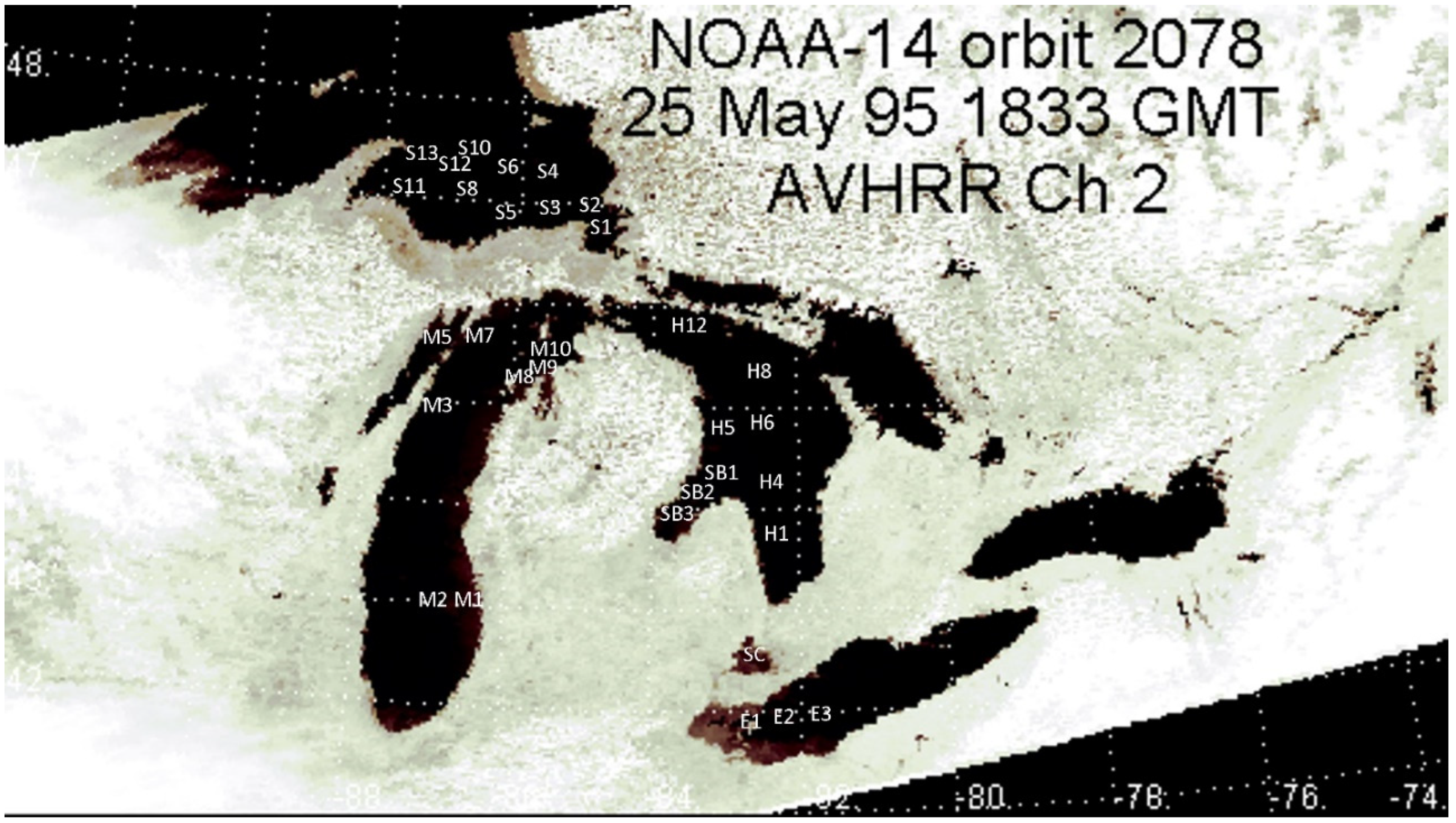
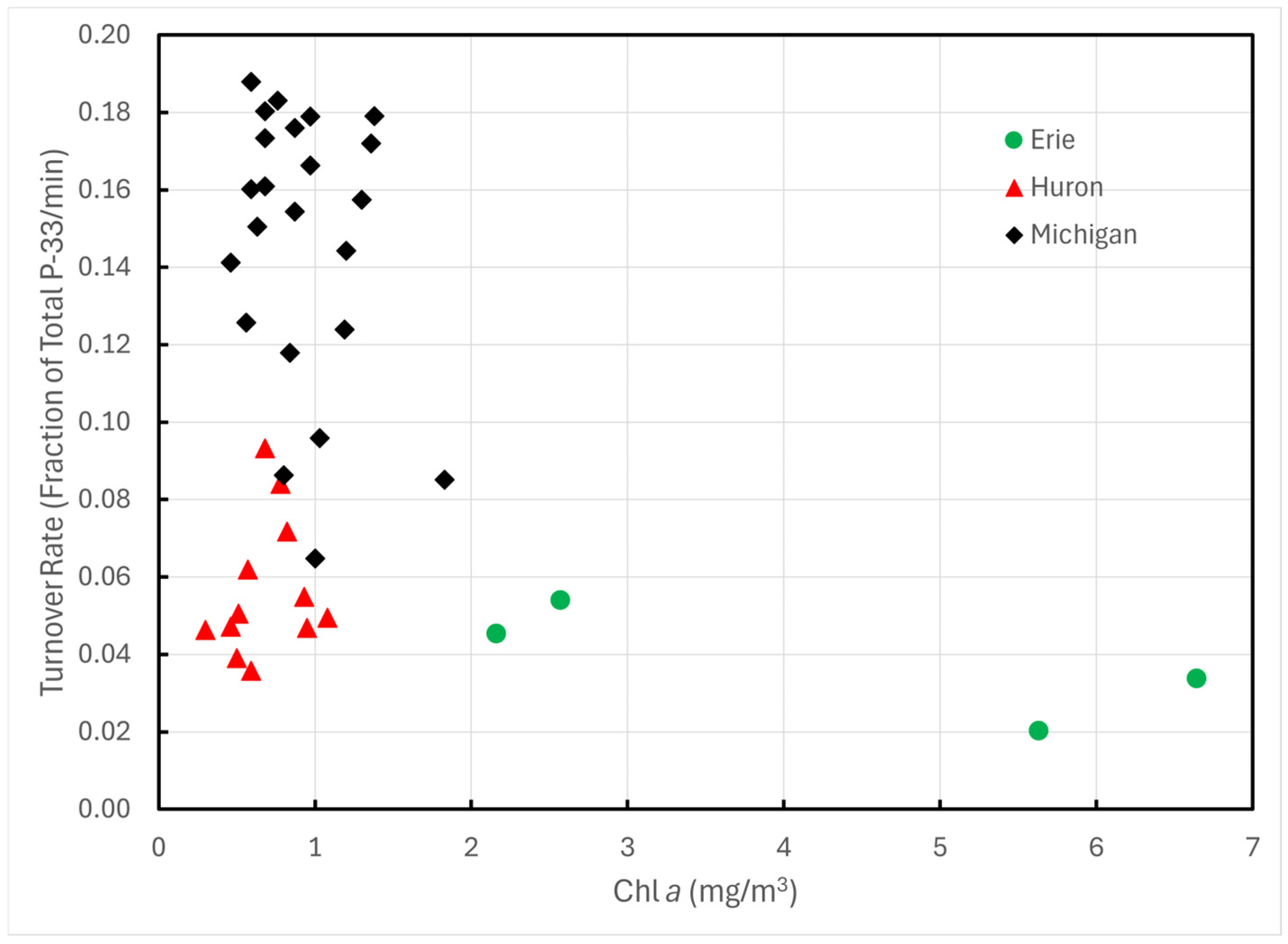
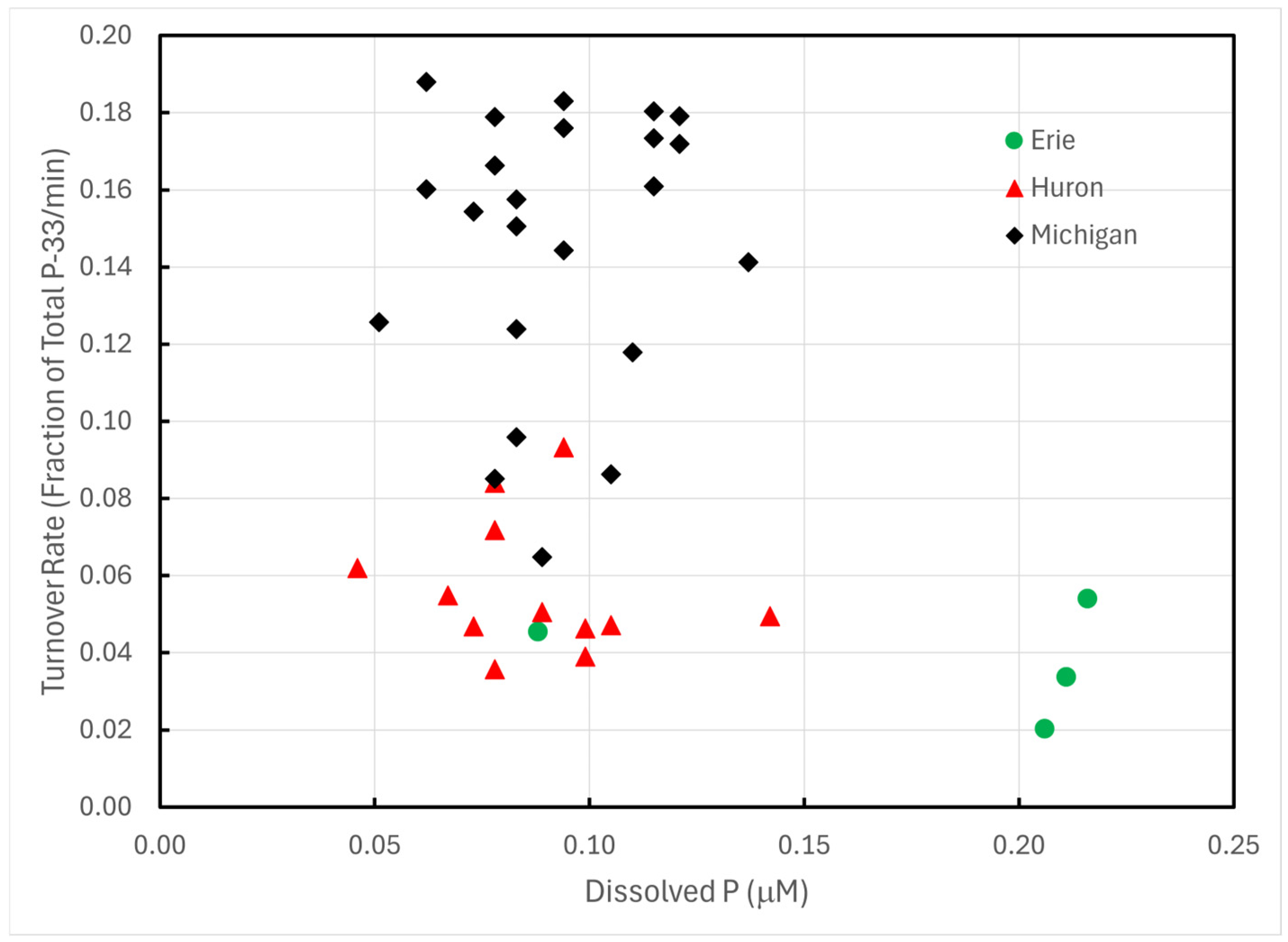
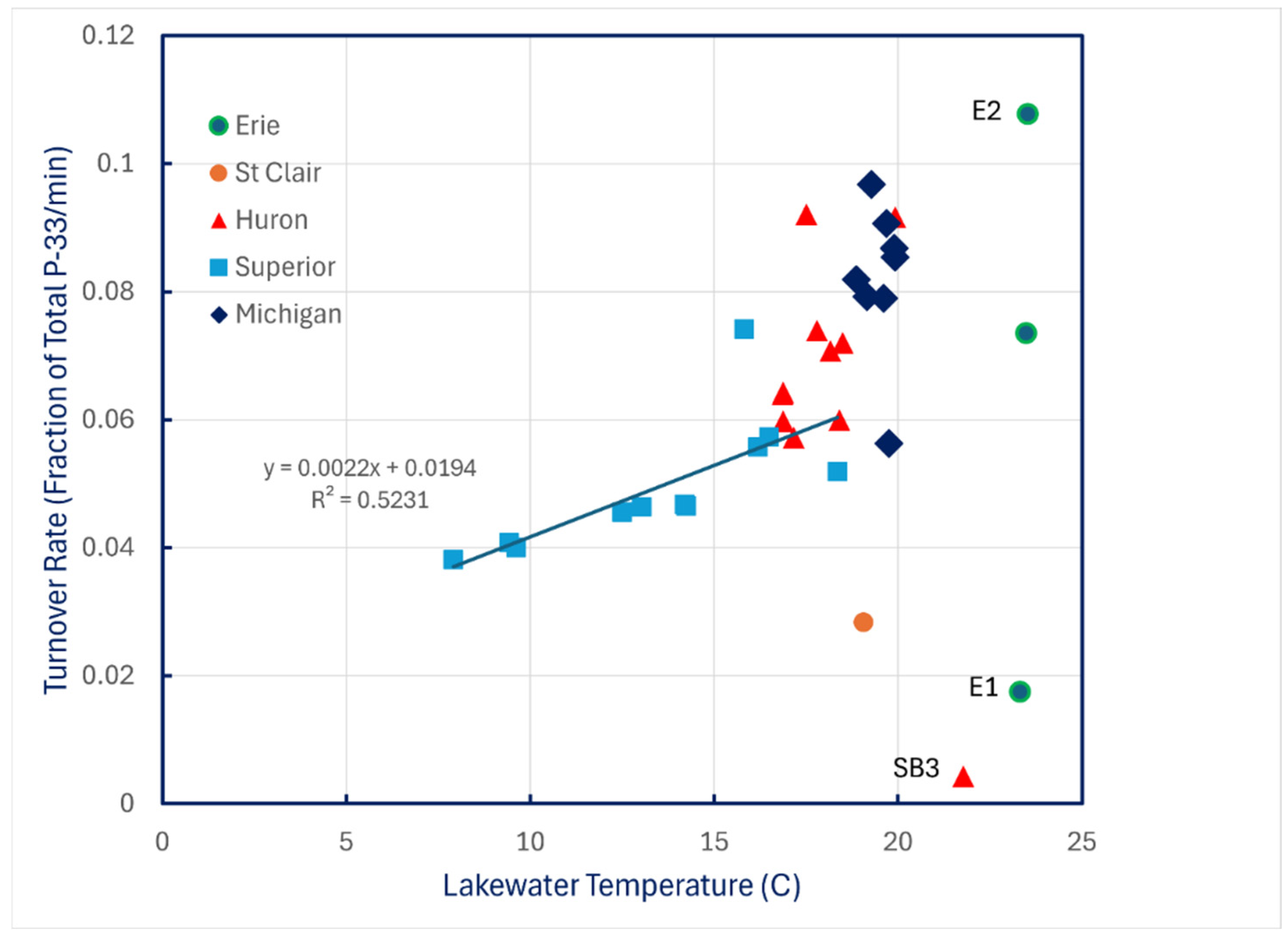
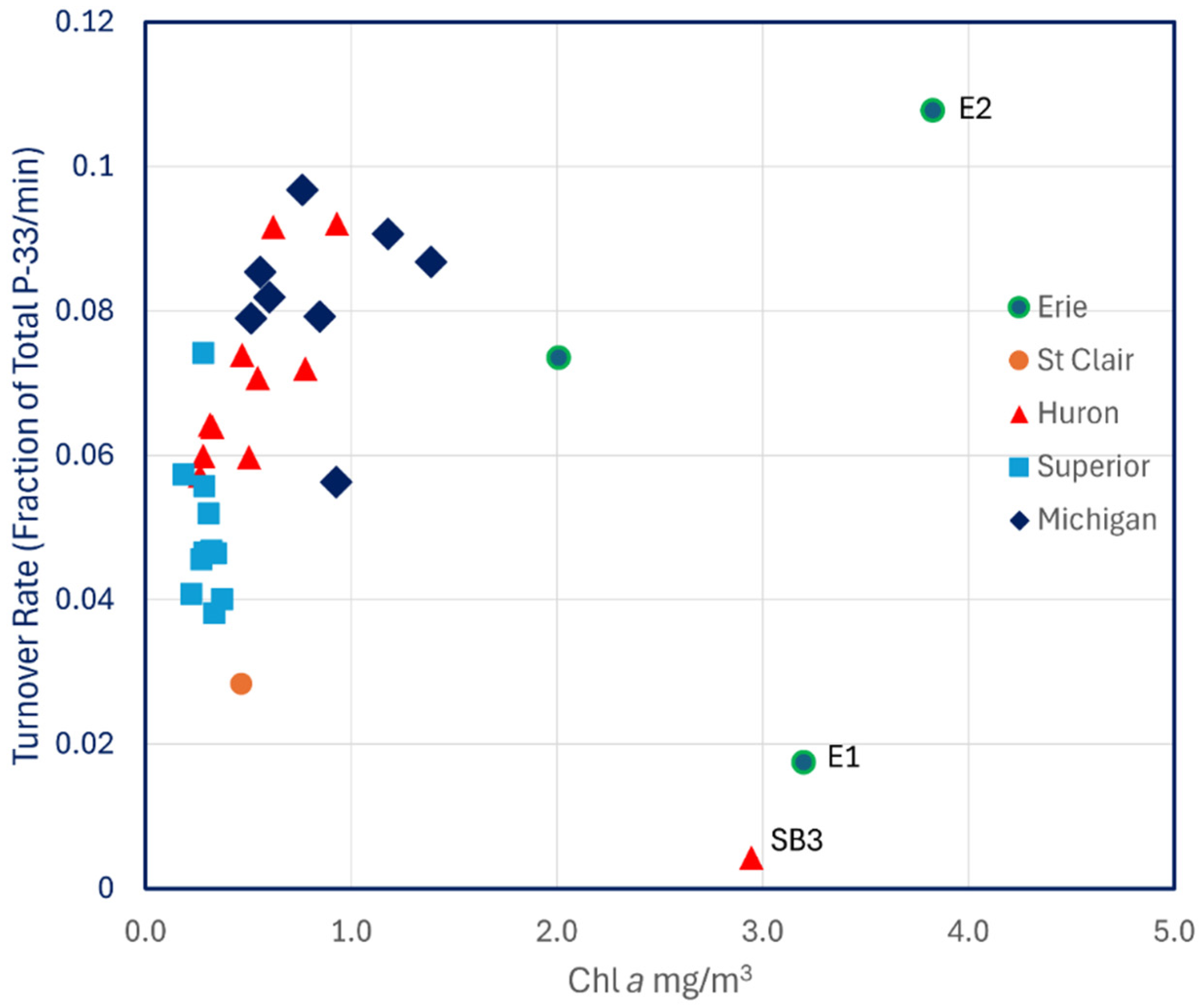
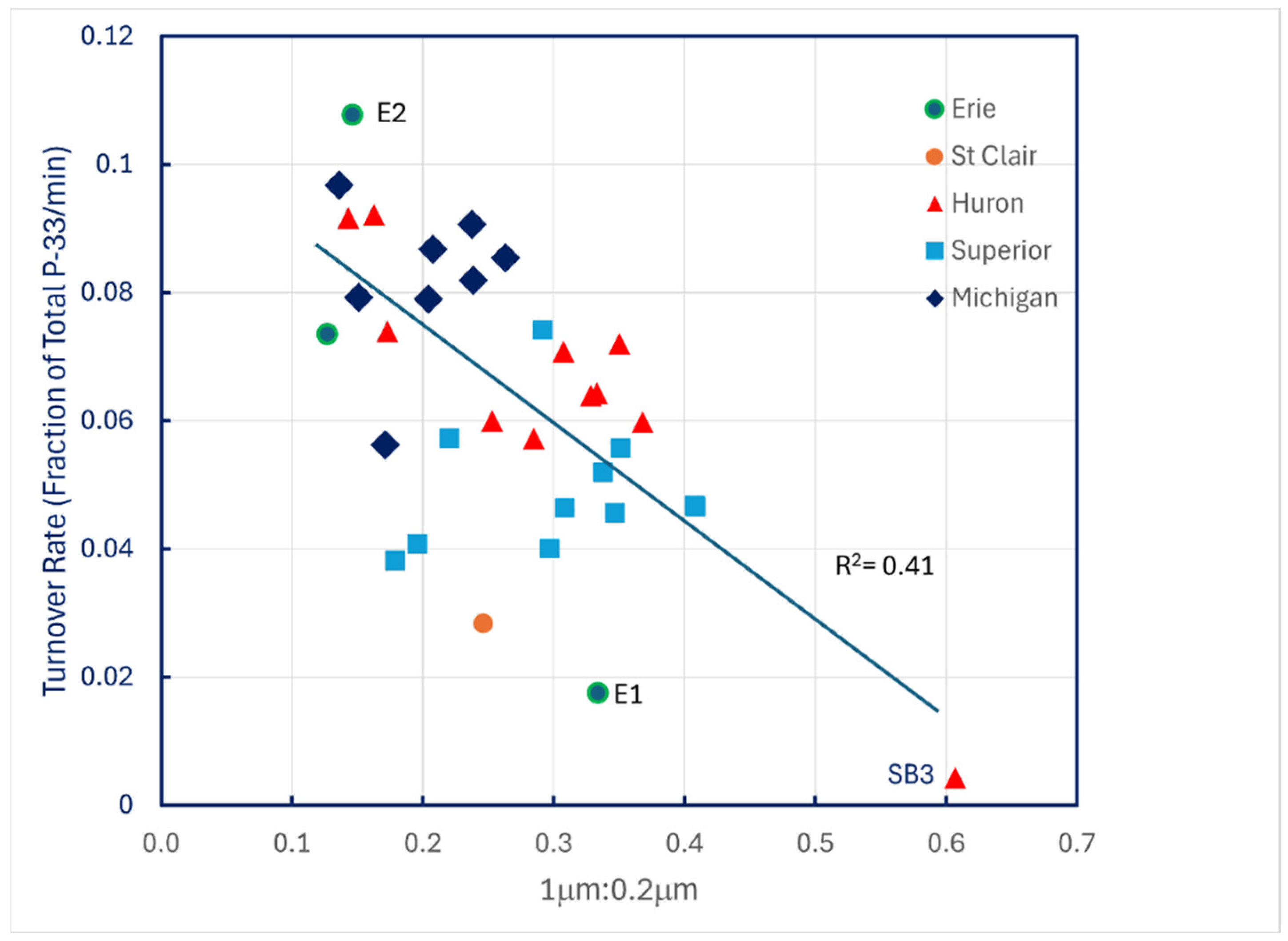

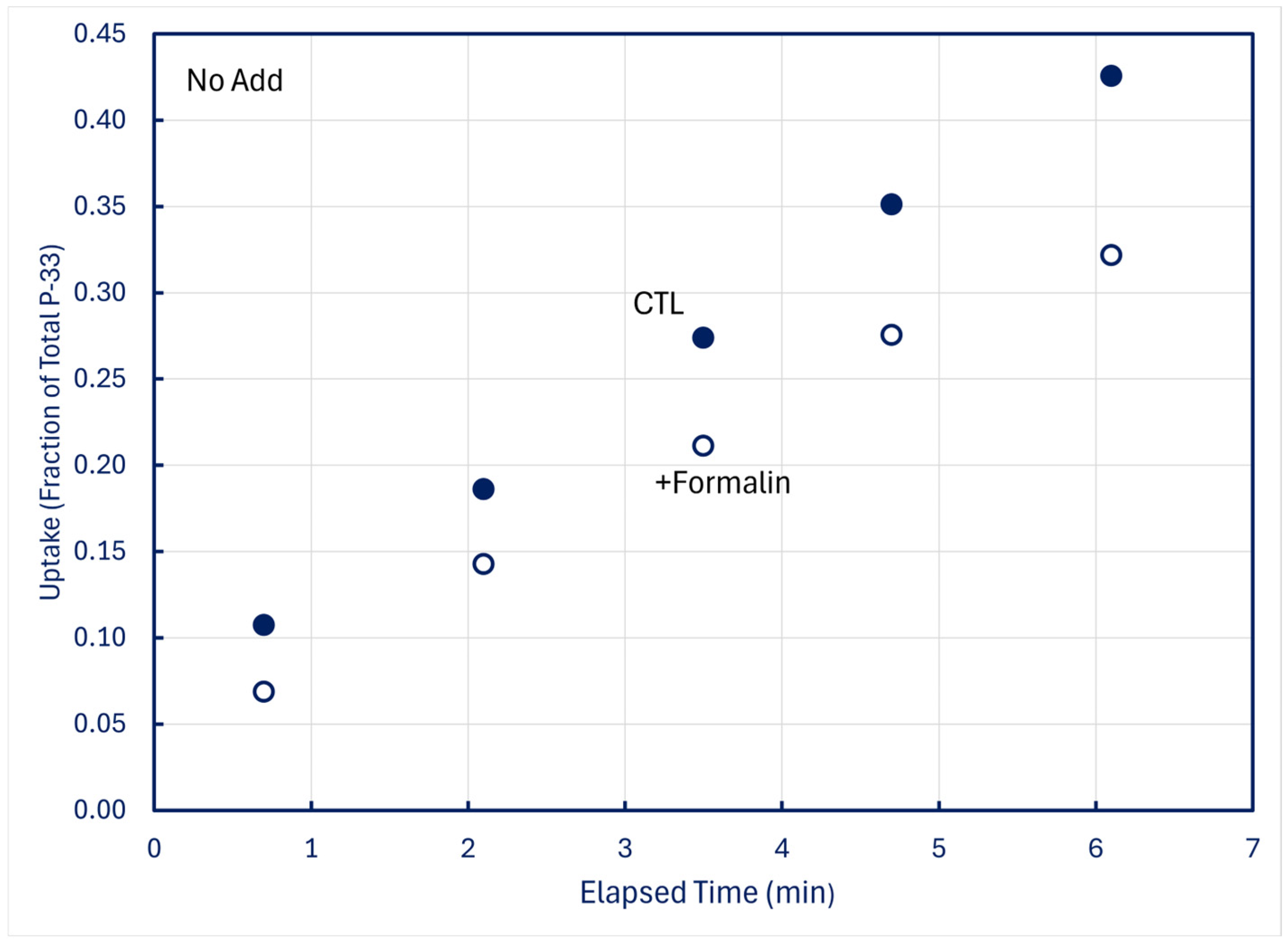
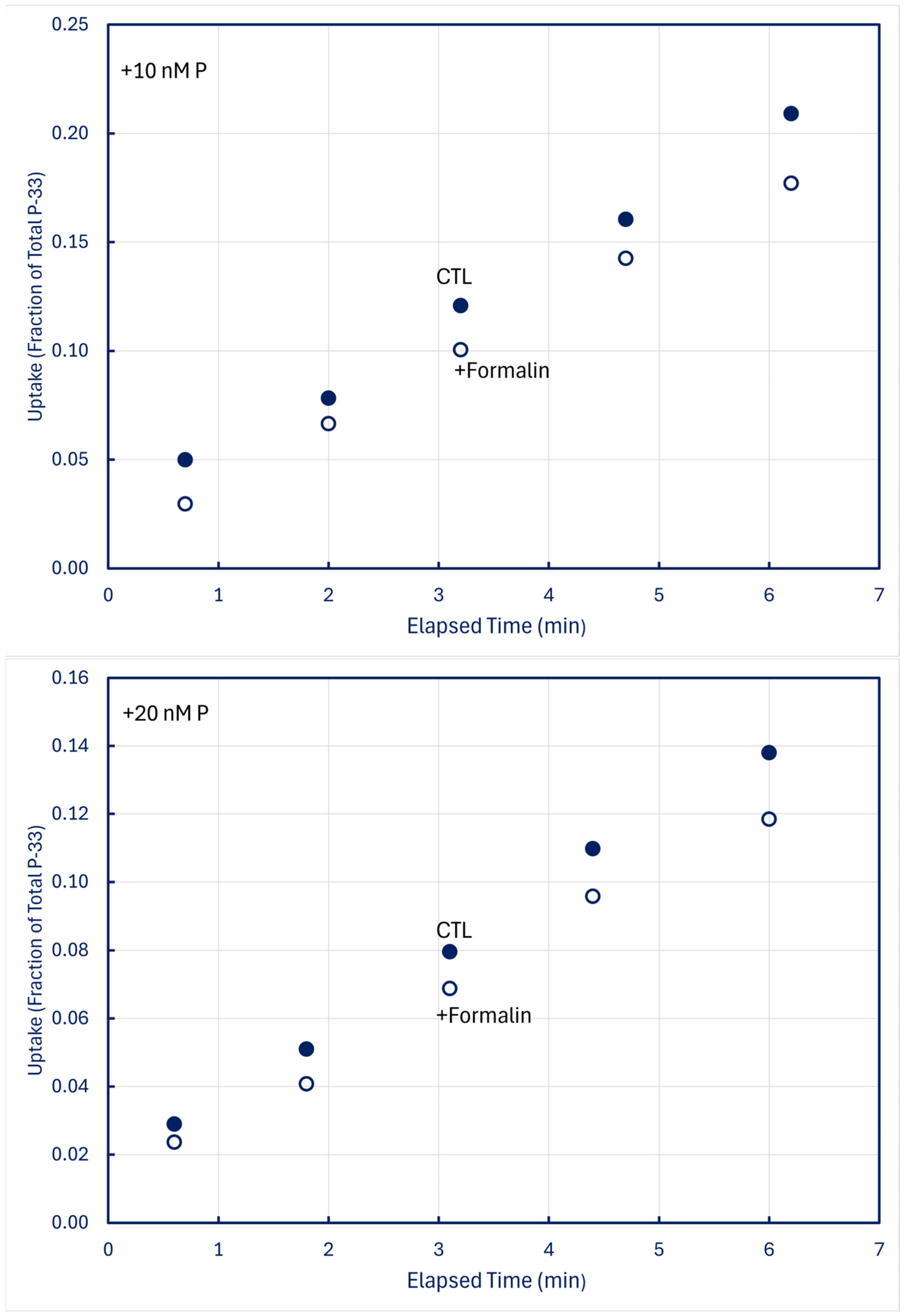

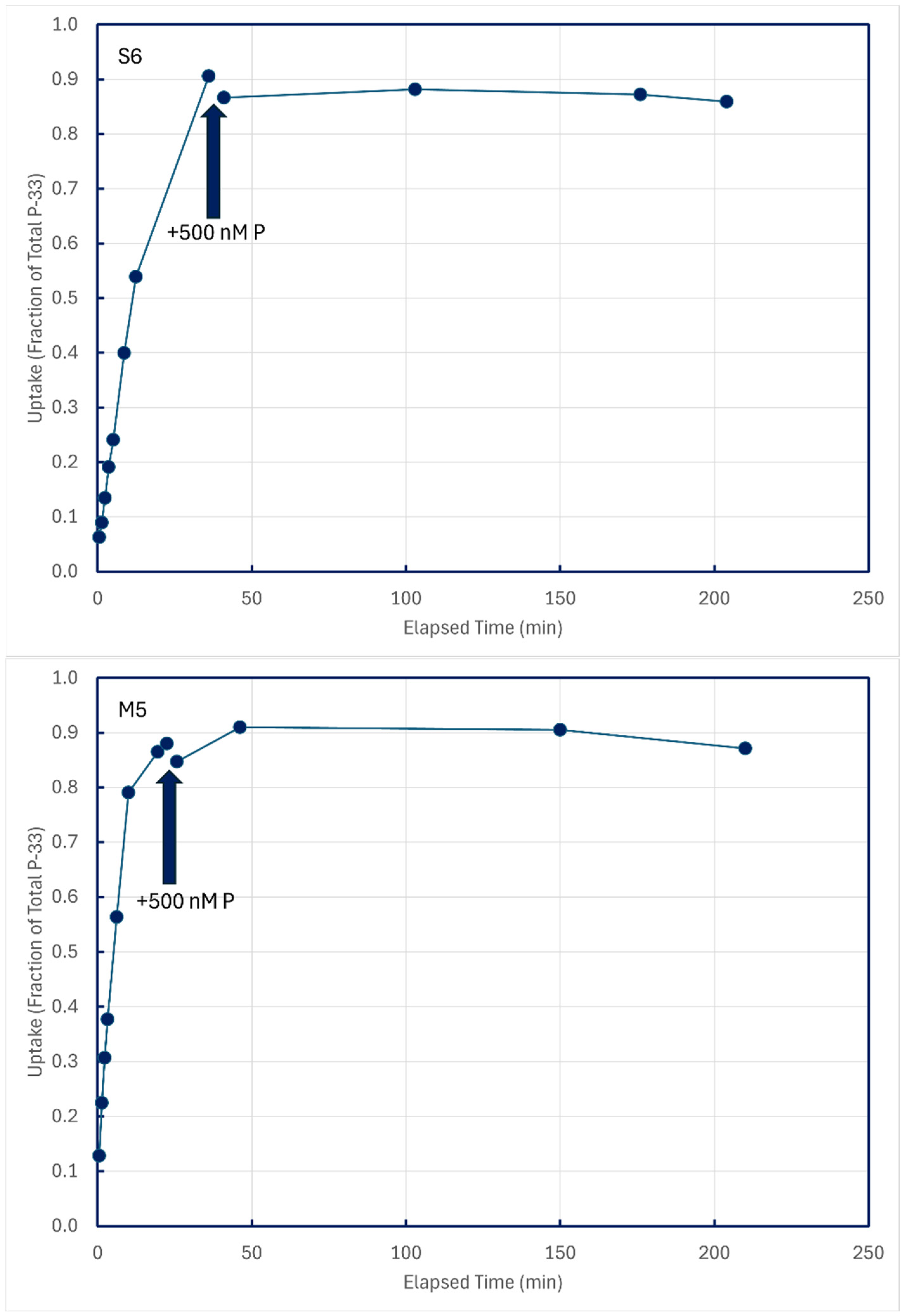
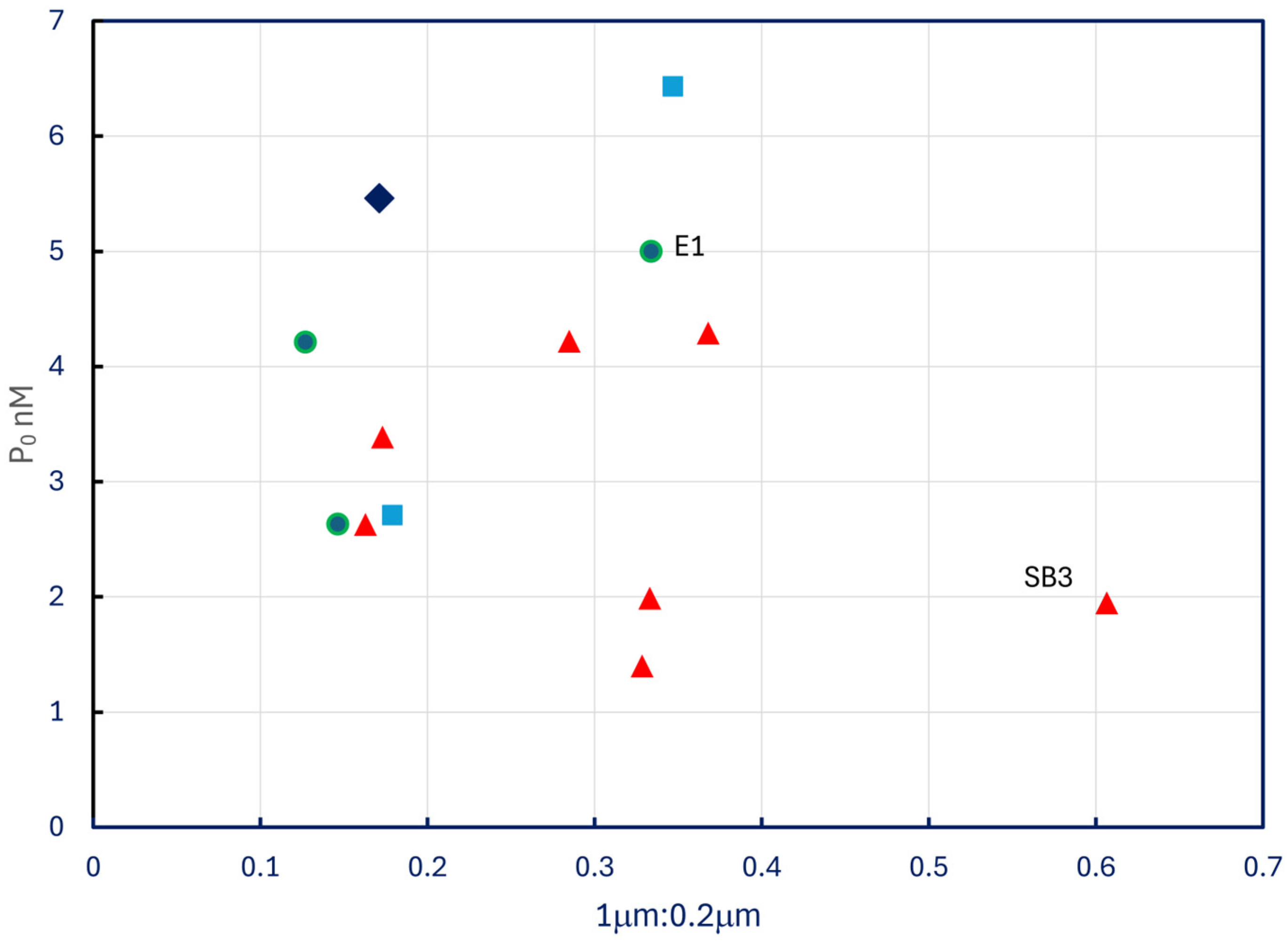
| Station ID | Latitude | Longitude | z |
|---|---|---|---|
| E1 | 41.605 | 82.657 | 10 |
| E2 | 41.665 | 82.268 | 15 |
| E3 | 41.722 | 81.883 | 20 |
| H1 | 43.500 | 82.500 | 20 |
| H3 | 43.500 | 82.233 | 50 |
| H4 | 44.167 | 82.500 | 64 |
| H6 | 44.500 | 82.555 | 50 |
| H10 | 45.750 | 84.252 | 20 |
| H11 | 45.750 | 84.063 | 40 |
| H12 | 45.750 | 83.550 | 106 |
| M1 | 43.000 | 86.267 | 20 |
| M2 | 43.000 | 86.667 | 100 |
| M3 | 43.077 | 87.838 | 20 |
| M4 | 43.187 | 87.668 | 100 |
| M5 | 44.142 | 87.495 | 20 |
| M7 | 44.018 | 87.395 | 83 |
| M9 | 45.000 | 86.200 | 20 |
| M11 | 45.000 | 86.443 | 142 |
| M16 | 44.460 | 87.430 | 40 |
| M17 | 44.500 | 87.300 | 100 |
| M21 | 45.500 | 86.643 | 20 |
| M22 | 45.500 | 86.620 | 40 |
| M23 | 45.500 | 86.482 | 100 |
| Station ID | Latitude | Longitude | z |
|---|---|---|---|
| E3 | 41.722 | 81.883 | 20 |
| E2 | 41.665 | 82.268 | 15 |
| E1 | 41.605 | 82.657 | 10 |
| SC | 42.500 | 82.703 | 4 |
| H1 | 43.500 | 82.500 | 20 |
| H4 | 44.167 | 82.500 | 64 |
| SB1 | 44.167 | 83.000 | 40 |
| SB2 | 44.083 | 83.500 | 11 |
| SB3 | 43.834 | 83.667 | 8 |
| H5 | 44.500 | 83.225 | 21 |
| H6 | 44.500 | 82.555 | 58 |
| H8 | 45.000 | 82.750 | 110 |
| H12 | 45.750 | 83.550 | 106 |
| S1 | 46.667 | 85.003 | 20 |
| S2 | 46.667 | 84.867 | 98 |
| S3 | 46.803 | 85.000 | 25 |
| S4 | 46.938 | 85.003 | 109 |
| S5 | 46.720 | 85.500 | 20 |
| S6 | 47.001 | 85.503 | 155 |
| S8 | 47.000 | 86.000 | 141 |
| S10 | 47.208 | 85.930 | 95 |
| S11 | 46.915 | 87.843 | 20 |
| S12 | 47.135 | 87.200 | 100 |
| S13 | 47.190 | 87.742 | 100 |
| M10 | 45.322 | 85.498 | 101 |
| M9 | 45.155 | 85.465 | 40 |
| M8 | 45.053 | 85.500 | 20 |
| M7 | 45.500 | 86.482 | 100 |
| M5 | 45.525 | 87.008 | 21 |
| M3 | 44.621 | 87.186 | 102 |
| M2 | 43.000 | 86.667 | 101 |
| M1 | 43.000 | 86.267 | 20 |
| Station | Treatment | Mean | SE | n | Temp | Chl a |
|---|---|---|---|---|---|---|
| H6 | no add | 0.783 | 0.052 | 5 | 16.87 | 0.31 |
| H6 | +10 nM P | 0.788 | 0.082 | 5 | 16.87 | 0.31 |
| H7 | no add | 0.783 | 0.037 | 5 | 18.16 | 0.55 |
| H8 | no add | 0.743 | 0.027 | 5 | 16.87 | 0.50 |
| H8 | +10 nM P | 0.802 | 0.053 | 5 | 16.87 | 0.50 |
| H8 | +20 nM P | 0.842 | 0.014 | 5 | 16.87 | 0.50 |
| H12 | no add | 0.739 | 0.036 | 5 | 18.49 | 0.78 |
| S1 | no add | 0.650 | 0.011 | 5 | 16.19 | 0.29 |
| S2 | no add | 0.628 | 0.037 | 5 | 15.82 | 0.28 |
| S3 | no add | 0.551 | 0.036 | 5 | 14.24 | 0.29 |
| M8 | no add | 0.830 | 0.040 | 5 | 19.92 | 0.56 |
| M9 | no add | 0.914 | 0.060 | 5 | 19.61 | 0.51 |
| M10 | no add | 0.799 | 0.023 | 5 | 18.87 | 0.60 |
| Station | Fraction of Total P-33/min | Prob |
|---|---|---|
| E3 | n.s. | 0.42 |
| SC | n.s. | 0.41 |
| H1 | n.s. | 0.37 |
| H2 | n.s. | 0.29 |
| H8 | n.s. | 0.38 |
| H12 | n.s. | 0.91 |
| S2 | n.s. | 0.16 |
| S5 | −0.0001 (0.000022) | 0.044 |
| S6 | n.s. | 0.66 |
| S11 | −0.00012 (0.000018) | 0.023 |
| S12 | n.s. | 0.13 |
| M5 | n.s. | 0.87 |
| Station | P0 nM | R2 | Uptake |
|---|---|---|---|
| E3 | 4.21 | 1.000 | 0.0084 |
| E2 | 2.63 | 1.000 | 0.0114 |
| E1 | 5.00 | 1.000 | 0.0028 |
| H4 | 4.22 | 1.000 | 0.0058 |
| SB1 | 3.39 | 1.000 | 0.0085 |
| SB2 | 2.63 | 1.000 | 0.0921 |
| SB3 | 1.95 | 1.000 | 0.0026 |
| H5 | 1.40 | 1.000 | 0.0158 |
| H6 | 1.99 | 1.000 | 0.0066 |
| H8 | 4.29 | 1.000 | 0.0044 |
| S4 | 6.43 | 1.000 | 0.0456 |
| S8 | 2.71 | 1.000 | 0.0025 |
| M2 | 5.46 | 1.000 | 0.0062 |
| Treatment | Mean | SE | n | Paired t-Test Probability |
|---|---|---|---|---|
| CTL (no add) | 0.27 | 0.11 | 30 | |
| +10 nM P | 0.32 | 0.12 | 14 | 0.0002 |
| +20 nM P | 0.37 | 0.10 | 12 | 0.0017 |
| +100 nM P | 0.37 | 0.09 | 10 | 0.005 |
| +300 nM P | 0.50 | 0.17 | 27 | <0.0001 |
Disclaimer/Publisher’s Note: The statements, opinions and data contained in all publications are solely those of the individual author(s) and contributor(s) and not of MDPI and/or the editor(s). MDPI and/or the editor(s) disclaim responsibility for any injury to people or property resulting from any ideas, methods, instructions or products referred to in the content. |
© 2025 by the author. Licensee MDPI, Basel, Switzerland. This article is an open access article distributed under the terms and conditions of the Creative Commons Attribution (CC BY) license (https://creativecommons.org/licenses/by/4.0/).
Share and Cite
Lehman, J.T. Historical Phosphorus Kinetics and Ambient Orthophosphate Concentrations in the St. Lawrence Great Lakes Erie, Huron, Michigan, St. Clair, and Superior by a Modified Inverse Isotope Dilution Method. Limnol. Rev. 2025, 25, 10. https://doi.org/10.3390/limnolrev25020010
Lehman JT. Historical Phosphorus Kinetics and Ambient Orthophosphate Concentrations in the St. Lawrence Great Lakes Erie, Huron, Michigan, St. Clair, and Superior by a Modified Inverse Isotope Dilution Method. Limnological Review. 2025; 25(2):10. https://doi.org/10.3390/limnolrev25020010
Chicago/Turabian StyleLehman, John T. 2025. "Historical Phosphorus Kinetics and Ambient Orthophosphate Concentrations in the St. Lawrence Great Lakes Erie, Huron, Michigan, St. Clair, and Superior by a Modified Inverse Isotope Dilution Method" Limnological Review 25, no. 2: 10. https://doi.org/10.3390/limnolrev25020010
APA StyleLehman, J. T. (2025). Historical Phosphorus Kinetics and Ambient Orthophosphate Concentrations in the St. Lawrence Great Lakes Erie, Huron, Michigan, St. Clair, and Superior by a Modified Inverse Isotope Dilution Method. Limnological Review, 25(2), 10. https://doi.org/10.3390/limnolrev25020010






